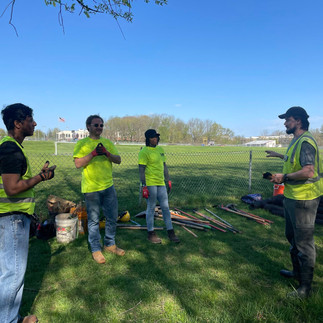EcoWorks' Sustainability Intern - Biochar Project Update Part 3
- Jazlyn Benitez
- May 27, 2024
- 4 min read
Updated: May 29, 2024
Hello and Happy May/June to the Howard EcoWorks Community! My name is Jazlyn Benitez, I am the Environmental Sustainability Intern at Howard EcoWorks! I am a Maryland native and am currently in graduate school to earn my M.S. in Sustainability Management.
I am excited to share one last and final update on a project concerning the forest-edge restoration efforts that will improve soil quality and eliminate harmful invasive species. This project is in partnership with Howard EcoWork’s Executive Director, Lori Lilly, as well with Kip Mumaw at Ecosystem Services and Dr. Paul Imhoff at the University of Delaware. Through the support of a Howard County Innovation Grant, we are bringing together a holistic approach to forest, stream, and soil management that maximizes ecosystem service benefits. In one of our projects, we are collaborating with Howard Community College to restore a forest-edge land. To learn more about the first and second phase of this project that took place, please read my first blog post January 2024 and second blog post April 2024.
Caption
Photo 1: HEW UpLift Crew & Nick Lovett, field technician.
Photo 2: Bare root tree
Photo 3: Project area at HCC.
On April 15th, the new spring/summer UpLift crew, Lori Lilly, and I all gathered at the project site along the soccer fields of Howard Community College. The final phase of the Biochar project was planting 100 barefoot native trees and adding the biochar that we previously made during the February 28th gathering, as previously discussed in my second blog post.
This was the first time the spring/summer UpLift crew had been to the HCC project, so I was very excited to inform them of the background efforts and objectives of this project. If feasible, Howard EcoWorks is interested in implementing biochar into other restoration efforts in the future.
While Lori and I cleared out a patch for all the designated spots for tree planting, the UpLift crew made their way across the field to dig a small hole and plant the native sapling into their new home. Each crew member was assigned to plant a particular tree, including Blackhaw, Southern Arrowwood, Pin Oak, and Witch Hazel.
Caption: planting native tree saplings into the ground after digging a shallow hole.
After planting, another crew member took charge of planting a stake next to the sapling, in order to later place a net for protection from predators. Since each native sapling was quite small in size, it also helped identify that a tree was in fact living there, and to warn others not to accidentally step over it.
Caption
Photo 1: Aaron placing a stake into the ground to offer support for the tree sapling)
Photo 2 & 3: Sample the bareroot and netting to surround the tree for protection.
Once the wrap was covering the native tree, the final steps were ready to occur! Along with plenty of water, each sapling received a hefty dose of biochar to serve as mulch. Lori and I took wagons to retrieve a large amount of biochar, and then brought it over to the site. The remaining biochar was then spread across the new forest edge area that was focused on for this project. Below is a picture of myself with the wagon full of biochar, as well as Lori.
Caption
Photo 1: Jazlyn with a wheelbarrow full of biochar.
Photo 2: Lori Lilly, Founder & Director of Howard EcoWorks, with a wheelbarrow full of biochar.
I was extremely grateful to offer support during this step, as I feel connected to this biochar since I have watched it transform during the entire duration of this project. The biochar was ready to be deployed to its new home and serve its new job: offer nutrients to the tree sapling while also sequestering its CO2 for many hundreds of years to come.

Now that the native trees have been planted and the biochar implemented in the experimental area. It is safe to say that this project is now wrapping up! While it is too soon to tell, we hope in the coming months we will be able to visit the HCC site and see the native tree saplings prospering in their new home, and the biochar assisting in maintaining a high level of porosity and retaining nutrients in the soil to allow enhanced plant growth.
Please stay tuned to updates on this project on our social media pages and blogs!
Howard EcoWorks hopes to utilize this project as a learning opportunity to demonstrate a more integrated approach to forest and woodland management through invasive species conversion to biochar in order to improve forest productivity and overall ecosystem function. Going forward, Howard EcoWorks hopes to add this to their service delivery model as well as generally educate the public about the benefits of biochar.

About the Author:
Jazlyn Benitez is from Silver Spring, MD and just recently graduated from St. Mary’s College of MD with a BA in Economics and Environmental Studies. Jazlyn is currently studying at American University’s Kogod School of Business for a MS in Sustainability Management while embarking on her Environmental Sustainability Internship here at Howard EcoWorks. Jazlyn enjoys swimming, going out to enjoy the Bay, and trying new places to eat!


























Comentarios